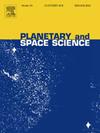新型LX月球风化模拟系统的性能——基础模拟系统:第2部分
IF 1.7
4区 物理与天体物理
Q3 ASTRONOMY & ASTROPHYSICS
引用次数: 0
摘要
只有当人类学会利用其他天体(如月球)的资源来建造定居点和基础设施,提取有价值的材料来生产次要商品,并获得维持生命和作为燃料的水和氧气等消耗品时,才有可能对太阳系进行可持续和快速的探索和殖民。月球上最丰富的资源是月球风化层,这是覆盖在月球表面的一层松散的粉状岩石材料,厚达数米。正在开发所谓的就地资源利用技术,以利用这种材料。为了在地球上开发和测试这些技术,模拟材料(模拟物)是必不可少的。在之前的研究中,为此开发了LX月球风化模拟系统,并对基础模拟物LX- t100和LX- m100进行了矿物学和化学、粒度分布、颗粒形态、密度、孔隙率和孔隙率的表征。本研究提出了基础模拟物综合表征的第二部分,旨在提供对其吸附行为和比表面积、可压缩性、流动特性、磁性和光学特性的详细见解。使用布鲁诺尔-埃米特-泰勒(BET)方法,比表面积被精确地量化,例如,它与月球尘埃的粘附性和反应性有关。可压缩性使用里程表测试来测量,从而深入了解模拟物在载荷作用下的沉降行为。通过一系列动态和静态测试来评估流动特性,包括休止角、豪斯纳比、流变学和直接剪切测量,以确定模拟物的处理和运输行为。对磁性进行表征以了解磁化率和剩余物,这对粉尘缓解策略和电磁干扰评估至关重要。利用分光光度法评估了相关波长的光谱反射率,为遥感校准和地表成分分析提供了有用的数据。结果表明,这些模拟物是模拟吸附、压缩和流动行为的良好模拟物。然而,它们表示磁性和光学性质的能力仍然有限。这些调查的结果有助于更全面地了解LX基地模拟,提高它们在科学研究中的保真度。本文章由计算机程序翻译,如有差异,请以英文原文为准。
Properties of novel LX lunar regolith simulant system — the base simulants: Part 2
Sustainable and fast exploration and colonisation of our solar system are only possible if humans learn to use the resources of other celestial bodies, such as our Moon, to build settlements and infrastructure, extract valuable materials for the production of secondary goods and obtain consumables such as water and oxygen for life support and as fuel. The most abundant resource on the Moon is the lunar regolith, a layer of loose pulverised rock material covering the Moons surface many meters thick. So-called ISRU (in-situ resource utilisation) technologies are being developed to make use of this material. To develop and test such technologies on Earth, analogue materials (simulants) are essential. In a previous study, the LX lunar regolith simulant system was developed for this purpose, and the base simulants LX-T100 and LX-M100 were characterised regarding their mineralogy and chemistry, particle size distribution, particle morphology, density, void ratio and porosity. This study presents the second part of a comprehensive characterisation of the base simulants, aimed at providing detailed insights into their adsorption behaviour and specific surface area, compressibility, flow properties, magnetic properties and optical properties. Using the Brunauer–Emmett–Teller (BET) method, the specific surface area was precisely quantified, being, for example, relevant to the adhesion and reactivity of lunar dust. Compressibility was measured using an oedometer test, providing insight into the settlement behaviour of the simulants under load. Flow properties were assessed through a series of dynamic and static tests, including angle of repose, Hausner ratio, rheometry and direct shear measurements, to determine the simulant’s handling and transportation behaviour. The magnetic properties were characterised to understand the magnetic susceptibility and remanence, which are crucial for dust mitigation strategies and electromagnetic interference assessments. Spectral reflectance was evaluated using spectrophotometry across relevant wavelengths, providing useful data for remote sensing calibration and surface composition analysis. It was shown that the simulants are good analogues for simulating adsorption, compression, and flow behaviour. However, their ability to represent magnetic and optical properties remains limited. The results from these investigations contribute to a more thorough understanding of the LX base simulants, enhancing their fidelity for scientific research.
求助全文
通过发布文献求助,成功后即可免费获取论文全文。
去求助
来源期刊

Planetary and Space Science
地学天文-天文与天体物理
CiteScore
5.40
自引率
4.20%
发文量
126
审稿时长
15 weeks
期刊介绍:
Planetary and Space Science publishes original articles as well as short communications (letters). Ground-based and space-borne instrumentation and laboratory simulation of solar system processes are included. The following fields of planetary and solar system research are covered:
• Celestial mechanics, including dynamical evolution of the solar system, gravitational captures and resonances, relativistic effects, tracking and dynamics
• Cosmochemistry and origin, including all aspects of the formation and initial physical and chemical evolution of the solar system
• Terrestrial planets and satellites, including the physics of the interiors, geology and morphology of the surfaces, tectonics, mineralogy and dating
• Outer planets and satellites, including formation and evolution, remote sensing at all wavelengths and in situ measurements
• Planetary atmospheres, including formation and evolution, circulation and meteorology, boundary layers, remote sensing and laboratory simulation
• Planetary magnetospheres and ionospheres, including origin of magnetic fields, magnetospheric plasma and radiation belts, and their interaction with the sun, the solar wind and satellites
• Small bodies, dust and rings, including asteroids, comets and zodiacal light and their interaction with the solar radiation and the solar wind
• Exobiology, including origin of life, detection of planetary ecosystems and pre-biological phenomena in the solar system and laboratory simulations
• Extrasolar systems, including the detection and/or the detectability of exoplanets and planetary systems, their formation and evolution, the physical and chemical properties of the exoplanets
• History of planetary and space research
 求助内容:
求助内容: 应助结果提醒方式:
应助结果提醒方式:


